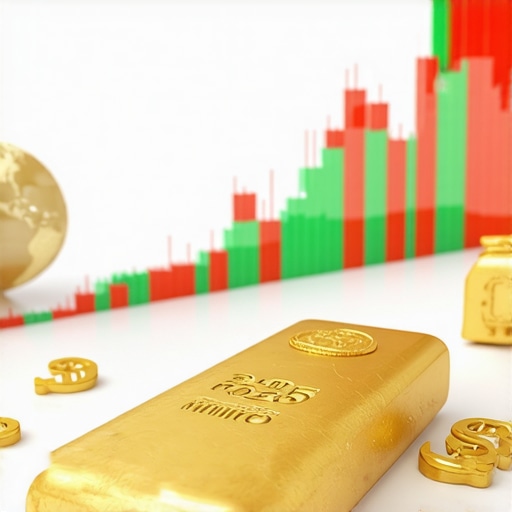Introduction to Gold Demand Trends
As investors look forward to 2025, understanding the gold demand trends becomes crucial for informed decision-making in the precious metals market. Gold has historically served as a safe haven during economic uncertainties, and its demand dynamics can fluctuate based on various factors, including geopolitical events, inflation, and changes in market sentiment. In this article, we will explore the key drivers influencing the demand for gold and what investors should keep an eye on in the coming years.
Key Drivers of Gold Demand in 2025
Several elements contribute to the shifting landscape of gold demand. Firstly, investor behavior plays a significant role. As economic conditions evolve, the inclination to invest in gold as a hedge against inflation or currency devaluation may increase. Furthermore, central banks are expected to continue their gold purchasing strategies, which can significantly impact market prices. Understanding how these purchases affect prices can provide investors with a competitive edge.
Central Bank Purchases
The actions of central banks are pivotal in shaping gold demand trends. In 2025, we may witness a continuation of aggressive purchases by central banks as they diversify their reserves and mitigate risks associated with fiat currencies. This trend was observed in previous years, where increased central bank buying has led to upward pressure on gold prices. For insights on how these purchases affect market dynamics, consider reading Understanding How Central Bank Gold Purchases Affect Prices.
Geopolitical Factors
Geopolitical tensions often lead to increased demand for gold as a safe-haven asset. In 2025, the ongoing global political climate will likely influence investor sentiment towards gold. Events such as trade disputes, conflicts, or economic sanctions can drive investors towards gold, anticipating its value to rise amidst uncertainty. For a deeper analysis of how geopolitical events impact gold prices, check out Understanding the Impact of Geopolitical Events on Gold Prices.
Emerging Markets and Investment Trends
Emerging markets are also expected to play a critical role in the demand for gold in 2025. Countries with growing middle classes, like India and China, are witnessing a surge in gold purchases for both investment and cultural reasons. This increasing demand from emerging markets can significantly shape global gold consumption patterns. For more on investing trends, visit The Latest Trends in Gold Demand: What Investors Should Know.
Conclusion
As we approach 2025, the landscape of gold demand will be influenced by various factors, including central bank purchases, geopolitical events, and emerging market trends. By understanding these trends, investors can position themselves advantageously in the gold market, ensuring they make informed decisions that align with their investment goals.
Impact of Inflation on Gold Demand
Inflation rates play a crucial role in influencing gold demand trends. As inflation rises, many investors turn to gold as a hedge against the eroding purchasing power of fiat currencies. In 2025, it’s anticipated that inflationary pressures will persist, particularly due to ongoing supply chain disruptions and economic recovery efforts. This scenario may lead to increased interest in gold as a protective asset. For insights into how inflation affects gold prices, check out Understanding Gold Price Forecasts: What Lies Ahead.
Consumer Behavior and Gold Purchases
Consumer behavior significantly impacts gold demand, especially in emerging markets. As more people recognize gold’s value as both an investment and a cultural asset, purchases are likely to rise. In countries like India, where gold jewelry holds traditional significance, demand is expected to stay robust. This cultural aspect, combined with investment trends, makes understanding consumer behavior essential for predicting future demand. For a deeper dive into consumer preferences, visit What’s Driving Gold Demand Trends in Today’s Market.
Technological Innovations and Their Effects
The gold market is also influenced by technological advancements. Innovations in mining and refining processes can affect gold supply and, consequently, its demand. In 2025, improvements in extraction technologies may lead to more efficient gold production, impacting prices and availability. Additionally, the rise of online trading platforms has made investing in gold more accessible to the average consumer, further driving demand. To explore how technology is reshaping gold investments, check out Exploring the Benefits of Investing in Gold ETFs for 2025.
The Role of Gold ETFs in Investment Strategies
Gold Exchange-Traded Funds (ETFs) have gained popularity among investors as a flexible way to gain exposure to gold without the need for physical ownership. In 2025, the trend of investing through gold ETFs is expected to continue as investors seek liquidity and ease of trading. Understanding the dynamics of gold ETFs can be beneficial for those looking to diversify their portfolios. For tips on maximizing returns with gold ETFs, refer to Maximize Your Returns with Gold Exchange-Traded Funds.
Global Economic Indicators and Their Influence
As we analyze gold demand trends, it’s essential to consider global economic indicators. Factors such as unemployment rates, GDP growth, and interest rates can significantly affect investor confidence and, subsequently, gold demand. In 2025, a fluctuating economic landscape may prompt investors to reassess their strategies. Monitoring these indicators will be vital for anticipating shifts in gold demand. For a comprehensive overview of how these factors interact with gold prices, visit Gold Market Analysis: Key Factors for Investors in 2025.
Investment Sentiment and Gold Demand
Investment sentiment plays a crucial role in shaping gold demand trends. As uncertainty looms in global markets, investors often seek the stability that gold provides. In 2025, we anticipate that geopolitical tensions and economic fluctuations will continue to impact investor confidence, leading to increased interest in gold. To understand how market psychology influences gold prices, consider visiting Gold Market Analysis: What to Watch in 2025.
Gold as a Hedge Against Market Volatility
Gold has long been viewed as a hedge against market volatility. In periods of market downturns or economic instability, investors typically flock to gold to preserve their wealth. This behavior is expected to persist in 2025, particularly in the wake of potential economic slowdowns. For insights into effective strategies for gold trading during volatile periods, check out Effective Strategies for Gold Trading in 2025’s Market.
Environmental and Ethical Considerations in Gold Mining
Another emerging factor influencing gold demand is the growing awareness of environmental and ethical issues related to gold mining. Investors are increasingly concerned about the sustainability of their investments, which has led to a rise in demand for responsibly sourced gold. In 2025, this trend is likely to continue, prompting investors to seek out gold investments that align with their values. For more information on ethical investing in gold, visit The Benefits of Investing in Gold Mutual Funds Explained.
Technological Advancements in Gold Production
Technological advancements are also reshaping the gold market. Innovations in mining techniques and sustainable practices can lead to more efficient gold production, potentially affecting supply and demand dynamics. As new technologies emerge, they may also influence the costs associated with gold extraction, which could impact market pricing. For a deeper understanding of these technological trends, explore Exploring the Benefits of Investing in Gold ETFs for 2025.
Global Economic Recovery and Its Impact on Gold Investment
The speed of global economic recovery will play a significant role in gold demand. As economies recover from the impacts of the COVID-19 pandemic, consumer spending and investment behaviors are likely to shift. In 2025, if the recovery accelerates, we may see a decrease in gold demand as investors turn to other asset classes. Conversely, if recovery is sluggish, gold may remain a favored option. For an overview of how economic indicators affect gold prices, visit Understanding Gold Price Forecasts: What Lies Ahead.
Gold Demand in Response to Inflationary Pressures
As we mentioned earlier, inflation remains a key driver of gold demand. With rising inflationary pressures expected in 2025, many investors may turn to gold as a safeguard against the decline in purchasing power. This trend could lead to heightened competition for gold, further driving up its value. For an in-depth analysis of inflation’s effects on gold prices, check out Gold Demand Trends: How They Affect the Market in 2025.
Exploring the Role of Gold in Portfolio Diversification
Gold is not just a commodity; it plays a vital role in portfolio diversification. As investors seek to mitigate risks and enhance returns, gold often emerges as a non-correlated asset that can stabilize a portfolio during turbulent market conditions. In 2025, understanding how to incorporate gold into investment strategies will be paramount for achieving financial resilience. For insights on how gold can enhance your investment portfolio, check out The Role of Gold in Portfolio Diversification: 2025 Tips.
Historical Performance of Gold as a Safe Haven Asset
Historically, gold has demonstrated its value as a safe haven asset, especially during periods of economic downturns. In times of crisis, such as during financial market volatility, gold prices typically rise as investors flock to its relative safety. This trend is likely to continue in 2025, as geopolitical uncertainties and economic fluctuations may prompt a surge in demand for gold. For a comprehensive analysis of gold’s historical performance and its implications for future investment, visit Gold Market Analysis: Trends to Watch in 2025.
Understanding the Impact of Economic Indicators on Gold Prices
Economic indicators such as inflation rates, interest rates, and employment statistics play a significant role in influencing gold prices. As these indicators fluctuate in 2025, they will shape investor sentiment and demand for gold. For instance, if inflation continues to rise, the attractiveness of gold as a hedge against currency devaluation will likely increase. Staying informed about these economic indicators is crucial for investors looking to time their gold purchases effectively. For an in-depth look at how these factors interact with gold prices, refer to 2025 Gold Market Dynamics: Key Factors for Investors.
Investor Sentiment and Market Psychology
Investor sentiment is a powerful driver of gold demand. In 2025, as uncertainties persist, market psychology will likely lean towards gold as a safety net. Understanding how fear and optimism influence investment choices can provide valuable insights for investors. Monitoring market sentiment and adjusting strategies accordingly will be essential for maximizing returns on gold investments. For more on how to navigate market psychology, consider reading Gold Market Analysis: What to Watch in 2025.
The Future of Gold Mining and Production Techniques
Advancements in mining and production techniques are set to reshape the gold market in 2025. Sustainable practices and innovations in extraction methods can significantly affect supply chains and market dynamics. As environmental awareness grows, investors may increasingly favor companies that adopt responsible mining practices. Understanding the future of gold mining can help investors identify opportunities that align with their values and investment goals. For insights into the latest trends in gold mining, check out Essential Insights into Gold Trading Techniques for 2025.
Evaluating the Risks Associated with Gold Investments
While investing in gold can offer numerous benefits, it is essential to evaluate the associated risks. Factors such as market volatility, regulatory changes, and geopolitical tensions can impact gold prices. Investors should conduct thorough research and stay informed about potential risks to make informed decisions. For practical tips on assessing risks in gold investments, visit Best Practices for Physical Gold Investments in 2025.
Frequently Asked Questions (FAQ)
What factors influence gold demand in 2025?
Gold demand in 2025 will be influenced by central bank purchases, geopolitical factors, inflation rates, and emerging market trends. Investors should closely monitor these elements to make informed decisions.
How does inflation affect gold prices?
Inflation typically drives investors to seek gold as a hedge against currency devaluation. As inflation rates rise, the attractiveness of gold as a protective asset also increases, potentially leading to higher demand and prices.
What role do central banks play in gold demand?
Central banks significantly impact gold demand through their purchasing strategies. In 2025, continued aggressive buying by central banks can lead to upward pressure on gold prices, as seen in previous years.
Why is gold considered a safe haven asset?
Gold is viewed as a safe haven asset due to its historical performance during economic instability. Investors often turn to gold to preserve wealth, especially during times of market volatility or geopolitical tensions.
How do emerging markets affect global gold consumption?
Emerging markets, particularly India and China, are expected to drive increased gold demand due to rising middle-class wealth and cultural significance attached to gold. This trend can significantly shape global gold consumption patterns.
What is the impact of technological advancements on gold mining?
Technological advancements in mining and refining processes can lead to more efficient gold production, affecting supply dynamics and potentially lowering production costs. This may influence gold prices and availability in the market.
How can investors diversify their portfolios with gold?
Investors can diversify their portfolios by including gold as a non-correlated asset. This can help stabilize returns during market downturns, making gold a valuable component of a well-rounded investment strategy.
What should investors consider when investing in gold ETFs?
When investing in gold ETFs, investors should consider factors such as liquidity, fees, and the underlying assets held by the ETF. Understanding these dynamics can help investors maximize their returns while minimizing risks.
How can economic indicators impact gold prices?
Economic indicators such as inflation rates, interest rates, and unemployment statistics significantly influence gold prices. Investors should stay informed about these trends to make timely investment decisions.
What resources can I consult for further information on gold investment?
For more in-depth knowledge about gold investments, consider consulting resources such as the World Gold Council, reputable financial news outlets, and investment research platforms that provide market analysis and insights.
Authority Resources
To deepen your understanding of gold demand trends and investment strategies, consider visiting the following trusted websites:
- World Gold Council – A leading authority on gold market trends and statistics.
- Reuters Commodities – Gold – Provides real-time news and insights on gold prices and market movements.
- Investing.com – Gold – An excellent resource for gold price charts and technical analysis.
- Kitco News – Offers comprehensive gold market news and analysis.
- Bloomberg Markets – Commodities – Up-to-date information on gold and other commodities from a financial perspective.
Conclusion
As we navigate through the complexities of the precious metals market, understanding the key drivers of gold demand in 2025 is essential for investors. Factors such as central bank purchases, geopolitical influences, and inflation will continue to shape the landscape. By leveraging insights from technological advancements, emerging market trends, and economic indicators, investors can position themselves strategically in the gold market. In a world of uncertainty, gold remains a steadfast asset that can enhance portfolio diversification and provide a hedge against market volatility. Stay informed, utilize trusted resources, and make decisions that align with your investment goals to thrive in the evolving landscape of gold demand.










This article provides a comprehensive overview of the key drivers shaping gold demand as we approach 2025. I find the emphasis on central bank purchases particularly interesting, given how much influence their reserve diversification strategies can exert on the market. In my own experience, staying updated on these central bank activities through resources like the World Gold Council has been invaluable in timing investments better.
One aspect I’ve been contemplating is how emerging technological advances might impact gold supply and price stability in the future. With innovations potentially making mining more cost-effective or sustainable, could we see a shift in typical demand patterns? I’m curious about how other investors are analyzing the balance between technological progress and environmental impact when making gold investment decisions. What strategies do you all think will be most effective in leveraging these trends while managing associated risks? Would love to hear different viewpoints on this effect of technology on the gold market.
Reading this in-depth analysis of gold demand drivers for 2025 really underscores how multifaceted the gold market is. I agree that central bank purchases have historically been a major influence, especially as countries diversify their reserves amid uncertain fiat currencies. From my perspective, the surge in demand from emerging markets like India and China will only grow, driven by cultural affinity and economic development. However, what’s often overlooked is how technological innovations could dramatically alter both supply and demand dynamics.
For instance, advancements in refining and mining technology might lower production costs and make gold more accessible, possibly dampening price volatility. On the flip side, if these innovations also lead to more sustainable and responsible mining practices, they could boost investor confidence, further pushing demand. Given these potential shifts, how do others see the balance between technological progress and its environmental implications impacting long-term gold demand and pricing? It seems like innovation could be both an opportunity and a challenge depending on how the market perceives these changes.